|
|

After you have installed your Cisco 7010, you need to connect it to the network. This chapter discusses how to connect each interface type to your network and how to connect console and auxiliary cables to your console terminal and auxiliary equipment.
Following are guidelines to assist you in properly connecting the external network cables.
 | Warning A voltage mismatch can cause equipment damage and may pose a fire hazard. If the voltage indicated on the label is different from the power outlet voltage, do not connect the chassis to that receptacle. |
The following sections discuss how to connect cables to all of the available interfaces on the Cisco 7010 interface processors and the main system processor.
An Ethernet transceiver or MAU should already be connected to your network. Connect each Ethernet port on the EIP to an Ethernet transceiver with a transceiver cable, or to an attachment unit with an AUI, as shown in Figure 4-1.
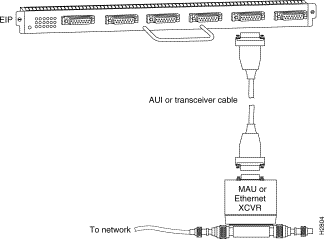
On each EIP port, slide the metal bracket up over two posts on the cable connector, or tighten the thumbscrews to secure the cable in the port and provide strain relief. Some miniature transceivers (usually the 10BaseT type) connect directly to the Ethernet port on the EIP and do not require an interface cable.
Token Ring MAU connectors provide a direct connection between the TRIP and the ring, as shown in Figure 4-2.

For an MII connection, a 100BaseT transceiver or MAU should already be connected to your network. An RJ-45 connection does not require an external transceiver. On a single 100BaseT port adapter, you can use either the RJ-45 connection or the MII connection. If you have two port adapters on your FEIP, you can use the RJ-45 connection on one and the MII connection on the other, as shown in Figure 4-3.
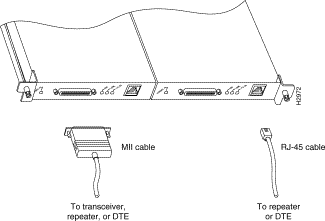
If you have RJ-45 connections, attach the Category 5 UTP cable directly to the RJ-45 port on the FEIP. If you have MII connections, attach an MII cable directly to the MII port on the FEIP, or attach a 100BaseT or 100BaseF transceiver, with the media appropriate to your application, to the MII port on the FEIP. RJ-45 and MII cables are not available from Cisco Systems, but are available from other cable vendors.
Attach the network end of your RJ-45 or MII cable to your 100BaseT or 100BaseF transceiver, switch, hub, repeater, DTE, or similar external 100BaseT equipment.
Specific CIP connection requirements for bus and tag or Enterprise System Connection (ESCON) cables are discussed in detail in the configuration note Channel Interface Processor (CIP) Installation and Configuration, which is available on UniverCD or as a printed copy (Document Number 78-1342-xx, where xx is the latest version of the document). This configuration note also ships with CIP-related spares.
Both single-mode and multimode, single and dual attachment connections can be combined on one FIP. Fiber-optic cable connects directly to FIP ports. Single-mode uses separate transmit and receive cables. All single-mode products meet the Class 1 Laser Emission Requirement from the Center for Devices and Radiological Health (CDRH) FDDI. Multimode uses one transmit/receive cable for each physical sublayer (PHY) interface. Connect single-mode, single attachment as shown in Figure 4-4.

 | Warning Invisible laser radiation may be emitted from the aperture ports of the single-mode FDDI card when no cable is connected. Avoid exposure and do not stare into open apertures. (For translated versions of this warning, refer to the appendix "Translated Safety Warnings.") |
The aperture port contains an FDDI warning label, as shown in Figure 4-5.

Connect multimode, single attachment as shown in Figure 4-6.

Connect single-mode, dual attachment as shown in Figure 4-7.

 | Warning Invisible laser radiation may be emitted from the aperture ports of the single-mode FDDI card when no cable is connected. Avoid exposure and do not stare into open apertures. (For translated versions of this warning, refer to the appendix "Translated Safety Warnings.") |
Connect multimode, dual attachment as shown in Figure 4-8.

For mixed-mode configurations, the primary ring signal is received on the multimode PHY A receive port and transmitted from the single-mode PHY B transmit port.
For mixed-mode configurations, connect the cables to the FIP ports as follows:
Your configuration may be opposite, with multimode connections on PHY B and single-mode connections on PHY A.
Connect mixed-mode configurations as shown in Figure 4-9.
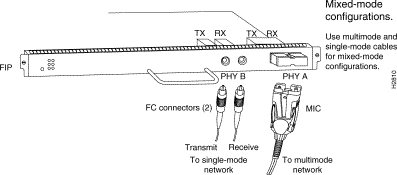
 | Warning Invisible laser radiation may be emitted from the aperture ports of the single-mode FDDI card when no cable is connected. Avoid exposure and do not stare into open apertures. (For translated versions of this warning, refer to the appendix "Translated Safety Warnings.") |
Connect the optical bypass switch as follows:
Step 1 Connect the cable coming in from the primary ring (from PHY B at the preceding station) to the PHY A receive port on the network (ring) side of the optical bypass switch.


Step 2 Connect the cable coming from the secondary ring (from PHY A at the preceding station) to the PHY B receive port on the network (ring) side of the bypass switch.
Step 3 Unless the documentation that accompanies the bypass switch instructs otherwise, consider the bypass switch to be an extension of the FIP ports and connect the switch cables from A to A and B to B. The network cables are already connected to the bypass switch following the standard B-to-A/A-to-B scheme.
Step 4 Connect the optical bypass switch control cable. If the control cable on your optical bypass switch uses a mini-DIN connector, connect the cable directly to the mini-DIN optical bypass port on the FIP. If the bypass switch uses a standard DIN connector, use the optical bypass adapter cable (CAB-FMDD), which is supplied with each FIP.
All FSIP ports support any available interface type and mode. The serial adapter cable determines the electrical interface type and mode of the port to which it is connected. EIA/TIA-232, EIA/TIA-449, V.35, and X.21 interfaces are available in DTE mode with a plug at the network end and in DCE mode with a receptacle at the network end. EIA-530 is available only in DTE mode with a plug. Connect the FSIP serial cables as shown in Figure 4-12.

When connecting serial devices, consider the adapter cables as an extension of the router for external connections. Therefore, use DTE cables to connect the router to remote DCE devices such as modems or DSUs, and use DCE cables to connect the router to remote DTE devices such as a host, PC, or another router.
A pair of metric thumbscrews is included with each port adapter cable. If you plan to connect to a remote device that uses metric hardware, replace the standard 4-40 thumbscrews at the network end of the port adapter cable with the M3 metric thumbscrews.
Figure 4-13 shows the correct and incorrect ways to attach serial interface cables to the FSIP.

The HIP port functions as a DTE when it is connected to a DSU for a standard High-Speed Serial Interface (HSSI) connection. It can also be connected to a collocated router with a null-modem cable. To connect the router to an HSSI network, use an HSSI interface cable between the HIP port and the DSU. HSSI cable ends are identical. Connect them as shown in Figure 4-14.

To connect two routers back to back in order to verify the operation of the HSSI port or to build a larger node, use a null-modem cable between available HSSI ports in two separate routers, as shown in Figure 4-15.

The two routers must be in the same location. When you configure the ports, you must enable the internal transmit clock on each HSSI interface with the hssi internal-clock command. When you disconnect the cable, use the no hssi internal-clock command. For complete descriptions of these commands, refer to the appropriate configuration publications, which are listed in the section "If You Need More Configuration Information," in the chapter "Performing a Basic Configuration of the Cisco 7010."
All AIP Asynchronous Transfer Mode (ATM) interfaces are full duplex. You must use the appropriate ATM interface cable to connect the AIP with an external ATM network. The AIP provides an interface to ATM switching fabrics for transmitting and receiving data up to 155 megabits per second (Mbps) bidirectionally. The actual data rate is determined by the physical layer interface module (PLIM).
The AIP can support PLIMs that connect to the following physical layers:
Connect AIP cables as shown in Figure 4-16.

 | Warning Invisible laser radiation may be emitted from the aperture ports of the single-mode FDDI card when no cable is connected. Avoid exposure and do not stare into open apertures. (For translated versions of this warning, refer to the appendix "Translated Safety Warnings.") |
The aperture port contains a warning label, as shown in Figure 4-17.

 | Caution To ensure compliance with EMI standards, the E3 PLIM connection requires an EMI filter clip (CLIP-E3-EMI) on the receive port (RCVR); the DS3 PLIM connection does not require this clip. The following procedure and figure discuss the EMI filter clip assembly that is required for the E3 PLIM. Do not operate the E3 PLIM without this assembly. |
Following is the procedure for installing the CAB-ATM-DS3/E3 cable and the EMI filter clip:
Step 1 Attach the CAB-ATM-DS3/E3 cable to the transmit (XMTR) and receive (RCVR) ports on the E3 PLIM, as shown in A in Figure 4-18.
One portion of the cable has a white insulator on both ends to ensure that the receive-to-transmit and transmit-to-receive relationship is maintained between the E3 PLIM and your ATM switch. The white banded portion of the cable should attach between receive and transmit or transmit and receive ports of the E3 PLIM and your ATM switch, respectively.
Step 2 Hold the EMI filter clip as shown in B in Figure 4-18.
Step 3 Attach the EMI filter clip to the receive cable as shown in C in Figure 4-18.
Step 4 To ensure that the clip is not pulled off when adjacent interface processors are removed, position the clip parallel to the orientation of the AIP as shown in D in Figure 4-18.
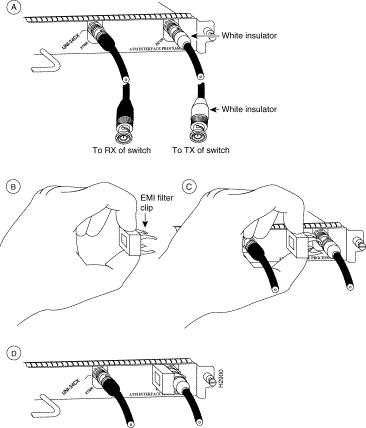
Two standard T1 serial cables are available from Cisco Systems and other vendors for use with the MIP: null-modem and straight-through. These T1 interface cables are used to connect your MIP to additional MIPs or external T1 CSUs, respectively.
You must use null-modem cables for MIP-to-MIP connections and straight-through cables for MIP-to-CSU connections. The T1 cables used to connect the MIP with external T1 equipment have DB-15 male connectors on each end.
Four E1 cables are available from Cisco Systems and other vendors for use with the MIP: BNC, Twinax, DB-15, and RJ-45. The E1 cables used to connect the MIP with external E1 equipment have a DB-15 male connectors on the MIP end.
Connect the MIP cables as shown in Figure 4-19.

The console port on the RSP1 is a DCE, DB-25 receptacle for connecting a data terminal, which you need to configure to communicate with your system. The auxiliary port is a DTE, DB-25 receptacle for connecting a modem or other DCE device (such as a CSU/DSU or other router) to the system.
Before connecting the console port, check your terminal's documentation to determine its baud rate, which must match the default baud rate (9600 baud) of the console port on the RP (or RSP7000). Set up the terminal as follows: 9600 baud, 8 data bits, no parity, 2 stop bits. On the RP (or RSP7000), the console port is located to the left of the auxiliary port.
Connect the console and auxiliary ports as shown in Figure 4-20.
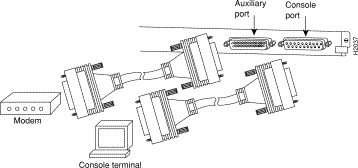
To connect a 600W AC-input power supply, simply connect the power cable between the AC-input power supply and the AC source, then secure the strain relief clip to the cable.
Following is the procedure for connecting a 600W DC-input power supply. You will need a medium flat-blade screwdriver, a nylon cable tie, and wire cutters for this procedure. Refer to Figure 4-21.
Step 1 Ensure that the DC-input power cable is disconnected from the DC power source and that the power switch on the power supply is in the off (O) position.
 | Warning Before performing any of the following procedures, ensure that power is removed from the DC circuit. To ensure that all power is OFF, locate the circuit breaker on the panel board that services the DC circuit, switch the circuit breaker to the OFF position, and tape the switch handle of the circuit breaker in the OFF position. (For translated versions of this warning, refer to the appendix "Translated Safety Warnings.") |
Step 2 Loosen the captive screws on the terminal block cover so the cover is free of the terminal block, as shown in A in Figure 4-21.
Step 3 Attach and tighten the ground wire to the ground terminal, as shown in D in Figure 4-21.
Step 4 Feed the 10-AWG, RTN and -48V wires through the large hole in the face of the terminal block cover, as shown in B in Figure 4-21. Feed a sufficient length (approximately 3 inches) of these two wires away from you, through the terminal block cover.
Step 5 Attach and tighten the RTN and -48V leads to the terminal block, as shown in D in Figure 4-21. Verify that you are connecting the appropriate leads to the correct terminal block posts. The color coding is up to you and must match the connections at the DC power source.
Step 6 Using a nylon cable tie that you provide, fasten the RTN and -48V leads to the terminal block cover, as shown in C in Figure 4-21. Insert the nylon cable tie through the small hole on the bottom of the terminal block cover and around the two leads. Carefully cut off the excess nylon cable tie with the wire cutters; do not cut the wires.
 | Warning The illustration shows the DC power supply terminal block. Wire the DC power supply using the appropriate lugs at the wiring end, as illustrated. The proper wiring sequence is ground to ground, positive to positive (line to L), and negative to negative (neutral to N). Note that the ground wire should always be connected first and disconnected last. (For translated versions of this warning, refer to the appendix "Translated Safety Warnings.") |

 | Warning After wiring the DC power supply, remove the tape from the circuit breaker switch handle and reinstate power by moving the handle of the circuit breaker to the ON position. (For translated versions of this warning, refer to the appendix "Translated Safety Warnings.") |
Step 7 Bundle the RTN and -48V wires behind the terminal block cover so that the cover fits over the wires and the terminal block, as shown in B in Figure 4-21. Take care not to strain the leads on the terminal block or crimp the wires behind the cover.
Step 8 Position the terminal block cover and tighten its screws, as shown in A in Figure 4-21.
Step 9 Connect the DC-input power cable to the DC power source.
The DC-input power supply connection is complete.
After you finish installing your Cisco 7010 hardware and connecting all the cables, and before you turn on the power, verify the following:
If you need more specific information on DC-input power attachments, refer to the configuration note 600W DC-Input Power Supply Replacement Instructions (Document Number 78-1455-xx) or the Cisco 7010 Hardware Installation and Maintenance publication.
After your hardware installation is complete, and all required cables are connected, proceed to the chapter "Performing a Basic Configuration of the Cisco 7010."
|
|